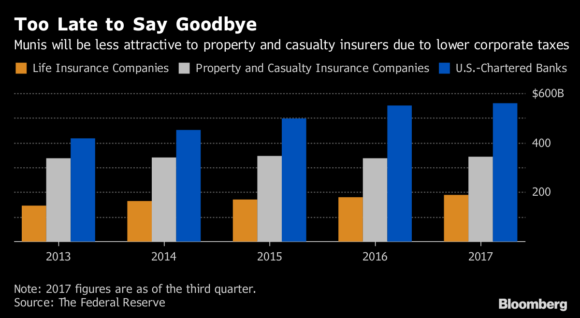Put on the Taylor Swift and pull out the Ben & Jerry’s ice cream: The municipal-bond market’s long relationship with property and casualty insurance companies may be breaking up.
That’s because last year’s tax overhaul slashed corporate rates to 21 percent, making tax-exempt debt less attractive to a segment of the insurance industry that has $342 billion in municipals, accounting for one-third of its debt investments, according to Federal Reserve data. That’s threatening to pose another potential drag on the $3.8 trillion market, where prices have been sliding amid concern the Federal Reserve will increase interest rates more aggressively to slow the economy.
“There’s really not going to be that much interest from insurance companies anymore,” said Rich Sega, chief investment officer of Conning, which manages investments on behalf of insurers and oversees more than $9 billion in municipal bonds. “On average, it just raises the cost of municipal financing.”
Property and casualty insurance companies are already looking to the exits. Citigroup Inc. analyst Vikram Rai said weaker demand from property and casualty insurers was one factor behind the recent downturn in the municipal market, which has already lost 1.3 percent so far this year.
Don McDonald, the chief executive officer of Prime Advisors, which oversees about $17 billion, is working with “many” companies on whether they should sell municipal bonds and shift into other asset classes.
Property and casualty insurers are likely to be “net sellers” in the first quarter, he said, forecasting that the companies’ allocations to municipals will drop by 2 to 4 percentage points during the quarter.
“New purchases would have less value,” McDonald said. “That’s the bottom line – there’s no question.”
Property and casualty companies have been “cautious” about buying more state and local debt since the tax bill was enacted in December and are likely waiting for interest rates to rise enough to make it worth while, said Matt Caggiano, who helps oversee more than $9 billion of insurers’ municipal holdings at Deutsche Asset Management.
Companies will be more attracted if municipals cheapen relative to U.S. Treasuries, he said, speculating that the entry point would be when yields on 30-year municipals rise above 100 percent of Treasuries. That gauge stood at about 96 percent on Wednesday.
Don’t Grab Tissues Yet
The portfolios that Caggiano helps oversee for property and casualty insurance companies have allocations to municipals ranging from about 30 to 50 percent, he said. While he anticipates they could cut the amount they allocate over the next year or two, he said it’s unlikely that they would reduce their overall muni holdings below 20 percent, given that the securities are among those least prone to default.
“You might see property and casualty insurers decide that’s the lowest they want to go,” he said.
Payden & Rygel Investment Management, which oversees $3 billion in tax-exempt and taxable municipals for clients including insurers, estimates that even with the lowered tax rates, AA and A rated municipals maturing in 20 and 30 years offer the same or higher after-tax yields than similar corporate bonds. That wasn’t the case with AAA and BBB rated municipals, according to an analysis of bonds maturing from two to 30 years.
But Ksenia Koban, a vice president at the firm, said the companies won’t exit the market completely. “Portfolios are still going to contain a good number” of the securities, she said.
Life insurers may also help make up for the drop-off in demand. Under the new tax law, those companies will pay taxes on just 30 percent of what they receive from tax-exempt municipal bonds, eliminating a previous uncertainty about how they would be taxed that gave them a disincentive to buy state and local debt.
Property and casualty insurance companies might be less interested in the tax-exempt municipal market, but they will likely still be big buyers of taxable municipals, a much smaller segment of the market that accounted for about $34 billion of sales last year.
Prime Advisors has added to its exposure to taxable municipals over the last two years, McDonald said. “Taxable municipals are a great alternative,” he said.
Was this article valuable?
Here are more articles you may enjoy.



 Adjusters Launch ‘CarFax for Insurance Claims’ to Vet Carriers’ Damage Estimates
Adjusters Launch ‘CarFax for Insurance Claims’ to Vet Carriers’ Damage Estimates  MAPFRE Accuses AAA of Violating Long-Time Exclusive Marketing Agreement
MAPFRE Accuses AAA of Violating Long-Time Exclusive Marketing Agreement  10 Highest Class-Action Settlements in 2025 Eclipsed $70B Total: Duane Morris
10 Highest Class-Action Settlements in 2025 Eclipsed $70B Total: Duane Morris  Consumer Acceptance of Telematics Widens, Says Survey
Consumer Acceptance of Telematics Widens, Says Survey 

